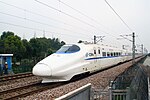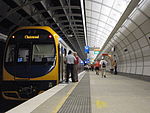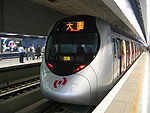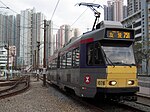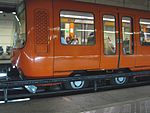鐵路運輸

铁路运输是指由任何形式的路轨引导列车的行走的一种交通工具。在狭义上通常是指一种以具有轮对的车辆沿铁路轨道运行,以达到运送旅客或货物目的的陆上运输方式。而广义的铁路运输尚包括磁悬浮列车、缆车、索道等并非使用车轮形式,但仍然沿特定轨道运行的运输方式,通称轨道运输或轨道交通。相比起路面运输工具,铁路运输被路轨所规限,不能自由行走。通常路轨是由钢铁制成,而且并安装在由木板或混凝土制作的路枕上。列车的轮距需要和轨距一致。
Rolling stock in railway transport systems generally has lower frictional resistance when compared with highway vehicles, and the passenger and freight cars (carriages and wagons) can be coupled into longer trains. The operation is carried out by a railway company, providing transport between train stations or freight customer facilities. Power is provided by locomotives which either draw electrical power from a railway electrification system or produce their own power, usually by diesel engines. Most tracks are accompanied by a signalling system. Railways are a safe land transport system when compared to other forms of transport.[Nb 1] Railway transport is capable of high levels of passenger and cargo utilization and energy efficiency, but is often less flexible and more capital-intensive than highway transport is, when lower traffic levels are considered.
The oldest, man-hauled railways date to the 6th century B.C, with Periander, one of the Seven Sages of Greece, credited with its invention. With the British development of the steam engine, it was possible to construct mainline railways, which were a key component of the industrial revolution. Also, railways reduced the costs of shipping, and allowed for fewer lost goods. The change from canals to railways allowed for "national markets" in which prices varied very little from city to city. Studies have shown that the invention and development of the railway in Europe was one of the most important technological inventions of the late 19th century for the United States, without which, GDP would have been lower by 7.0% in 1890. In the 1880s, electrified trains were introduced, and also the first tramways and rapid transit systems came into being. Starting during the 1940s, the non-electrified railways in most countries had their steam locomotives replaced by diesel-electric locomotives, with the process being almost complete by 2000. During the 1960s, electrified high-speed railway systems were introduced in Japan and a few other countries. Other forms of guided ground transport outside the traditional railway definitions, such as monorail or maglev, have been tried but have seen limited use.
历史
[编辑]种类
[编辑]用途
[编辑]设备
[编辑]列车
[编辑]路轨
[编辑]信号
[编辑]供电
[编辑]设施
[编辑]车票
[编辑]纸制车票
[编辑]胶制车票
[编辑]电子货币
[编辑]安全
[编辑]无障碍运输
[编辑]铁路公司运作
[编辑]财政管理
[编辑]公益活动
[编辑]建造铁路
[编辑]铁路迷
[编辑]现时还未有铁路的国家
[编辑]参考资料
[编辑]- 备注
- ^ According to this source, railways are safest on both a per-mile and per-hour basis, whereas air transport is safe only on a per-mile basis
- 参考资料

